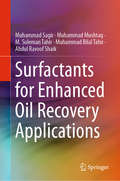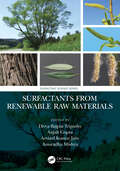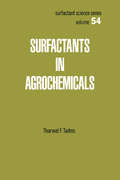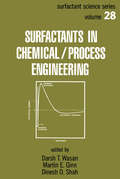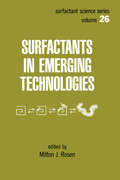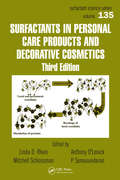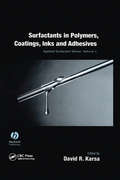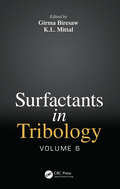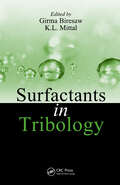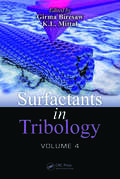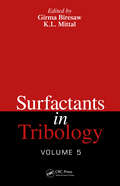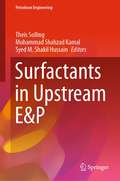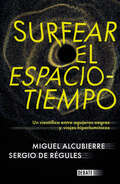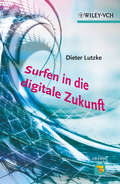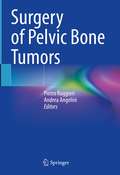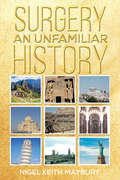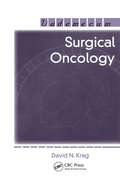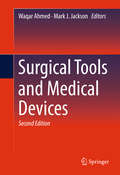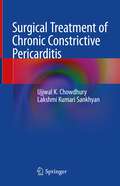- Table View
- List View
Surfactants for Enhanced Oil Recovery Applications
by Muhammad Sagir Muhammad Mushtaq M. Suleman Tahir Muhammad Bilal Tahir Abdul Ravoof ShaikThis book provides a concise treatise on the use of surfactants in enhanced oil recovery (EOR), including information on key types of surfactants and their respective applications in the wider petroleum industry. The authors discuss carbon dioxide EOR, alkaline-surfactant-polymer flooding strategies, and the use of surfactants as a means of reducing interfacial tension, while also paying special attention to the challenges involved in using surfactants for enhanced oil recovery, such as the difficult issue of surfactant adsorption on reservoir rock. All chapters highlight and are based on the authors’ own laboratory-scale case studies. Given its content, the book offers a valuable asset for graduate students of petroleum and chemical engineering, as well as researchers in the field of chemical enhanced oil recovery. It will also be of interest to professionals involved in enhanced industrial oil recovery.
Surfactants from Renewable Raw Materials (Surfactant Science)
by Anuradha Mishra Arvind Kumar Jain Divya Bajpai Tripathy Anjali GuptaSurfactants are often completely invisible to us and yet they are present in almost every chemical that we use in our daily life. They are found in toothpastes, cosmetics, sunscreens, mayonnaise, detergents, and an array of cleaning products. Traditional surfactants are known to have adverse environmental impacts spurring research into eco-friendly and cost-effective surfactants from renewable resources. Surfactants from Renewable Raw Materials examines the class of surfactants synthesized using plant-based raw materials detailing their properties, applications, bioavailability, and biodegradability. The concluding chapter reviews patent activity over the last decade. Additional features include: Addresses the tremendous variation found in the raw materials used to synthesize commercially available surfactants. Explores the selection of raw materials based upon the desired hydrophobic group or hydrophilic group to be incorporated into the product. Examines the characteristics and medicinal applications of pulmonary surfactants in preterm babies as well as their probable contribution in COVID-19 Discusses the biodegradability of surfactants to assist with the determination of truly green surfactants. This comprehensive reference will prove indispensable for professional and academic researchers creating or working with bio-based surfactants.
Surfactants in Agrochemicals (Surfactant Science Ser. #54)
by TharwatF. TadrosThis work highlights the physical chemistry of surfactant solutions, detailing a fundamental method of selecting surfactants for agrochemical formulations and delineating how surfactants enhance the biological efficacy of agrochemicals. The unique properties of surfactants that have a major influence on the performance of an agrochemical are summarized.;The book is intended for physical, surface and colloid chemists; biochemists; microbiologists; agronomists; research and development personnel in the pesticide and fertilizer industries; and upper-level undergraduate and graduate students taking chemistry and chemical engineering courses.;College and university bookstores may order five or more copies at a special price which is available on request from Marcel Dekker Inc.
Surfactants in Chemical/Process Engineering (Surfactant Science Ser. #28)
by WasanThe first reference to link chemical engineering technologies and surfactant science in suchbreadth of focus, Surfactants in Chemical/Process Engineering features contributionsby major authorities in chemical engineering whose applications have opened important newfields for surfactant use. These applications include dispersion science, separation processes, oilrecovery, microemulsions, and environmental control.This volume discusses ultrafiltration processes, flotation, metal extractions, and more ...examines surfactants in process streams for such industrial separations as micellar-enhancedultrafiltration, adsorbent regeneration, micellar extractions, and oiVwater demulsification . ..describes methodologies for separations of fatty acids, metals, minerals and impurities,solvents, and hydrocarbons for cost-saving industrial and consumer product manufacture . . .details techniques for developing and optimizing formulations for superior agricultural plantcontrol or enhancement systems, micro- and macroemulsions, and liquid surfactant membranes... and looks closely at emulsion polymers in soil stabilizations, protective coatings, sealants,adhesives, textile processing, paper finishing, specialty concretes, and tire manufacture.
Surfactants in Cosmetics (Surfactant Science #68)
by Martin M. Rieger Linda D. Rhein""Second Edition provides a thorough, up-to-date treatment of the fundamental behavior of surface active agents in solutions, their interaction with biological structures from proteins and membranes to the stratum corneum and epidermis, and their performance in formulations such as shampoos, dentifrice, aerosols, and skin cleansers.
Surfactants in Emerging Technology
by Milton J. RosenThis book is based on the proceedings of the conference "The role of surfactants in new and emerging technology". It examines the position of surfactants in the new growth areas, and describes the needs for surfactant research to facilitate advances in those areas.
Surfactants in Personal Care Products and Decorative Cosmetics (Surfactant Science)
by Linda D. Rhein P. Somasundaran Mitchell Schlossman Anthony O’LenickFrom anti-aging creams to make-up, surfactants play a key role as delivery systems for skin care and decorative cosmetic products. Surfactants in Personal Care Products and Decorative Cosmetics, Third Edition presents a scientific basis in surfactant science and recent advances in the industry necessary for understanding, formulating, and te
Surfactants in Polymers, Coatings, Inks, and Adhesives
by David R. KarsaSurface active agents are used as process aids in the production of polymers--as additives to impart or modify polymer properties--and in the formulation and further processing of polymeric systems for a variety of applications. In all these uses, the surfactants are used as 'effect chemicals,' to impart specific performance characteristics or properties to the base polymer or to enhance it performance when formulated for a specific end use.This volume focuses on those surfactant areas incorporating the greatest number of supplier and user companies. Authors have been selected from leading industrial and academic laboratories around the world. It provides an introduction to the underlying chemistry and technology in these industrial areas, and at the same time, highlights important recent developments.Surfactants in Polymers, Coatings, Inks and Adhesives is a book for surfactant researchers and for manufacturers and users of surfactants. In particular, surfactant chemists, analytical chemists, environmental chemists, users of surfactant formulations in the fields of specialty chemicals, polymers, and detergents, and health and safety personnel.
Surfactants in Solution (Surfactant Science Ser. #64)
by Arun K. Chattopadhyay; K. L. MittalContains selected invited papers presented at the 10th International Symposium on Surfactants in Solution held in Caracas, Venezuela. The volume covers phase behaviour of monolayers, contact angle hysteresis, micellar relaxation, micellar catalyzed reactions, polymerization in microemulsions, polymer-surfactant complexation, asphaltenes, and more.
Surfactants in Tribology
by K. L. Mittal Girma BiresawSurfactants play a critical role in Tribology controlling friction, wear, and lubricant properties such as emulsification, demulsification, bioresistance, oxidation resistance, rust prevention and corrosion resistance. This is a critical topic for new materials and devices particularly those built at the nanoscale. This newest volume will address important advances, methods, and the use of novel materials to reduce friction and wear. Scientists from industrial research and development (R&D) organizations and academic research teams in Asia, Europe, the Middle East and North America will participate in the work.
Surfactants in Tribology, Volume 1
by K. L. Mittal Girma BiresawSurfactants play a variety of critical roles in tribology. In addition to controlling friction and wear, they also allow for control of a wide range of properties of lubricants, such as emulsification/demulsification, bioresistance, oxidation resistance, and rust/corrosion prevention. This book explains recent advances in the role of surfactants wi
Surfactants in Tribology, Volume 2
by K. L. Mittal Girma BiresawThe premier symposium on Surfactants in Tribology, held in Seoul in 2006, was an enormously successful event that generated a high level of interest in the topic, leading to the publication of the first volume in this series in 2008. The tremendous response was echoed at the follow-up symposium in Berlin that same year, and leading researchers, man
Surfactants in Tribology, Volume 3
by Girma Biresaw Kashmiri Lal MittalThe manufacture and use of almost every consumer and industrial product rely on application of advanced knowledge in surface science and tribology. These two disciplines are of critical importance in major economic sectors, such as mining, agriculture, manufacturing (including metals, plastics, wood, computers, MEMS, NEMS, appliances), construction
Surfactants in Tribology, Volume 4
by K. L. Mittal Girma BiresawSurface science and tribology play very critical roles in many industries. Manufacture and use of almost all consumer and industrial products rely on the application of advanced surface and tribological knowledge. The fourth in a series, Surfactants in Tribology, Volume 4 provides an update on research and development activities connecting surfacta
Surfactants in Tribology, Volume 5
by K. L. Mittal Girma BiresawSurfactants play a critical role in Tribology controlling friction, wear, and lubricant properties such as emulsification, demulsification, bioresistance, oxidation resistance, rust prevention and corrosion resistance. This is a critical topic for new materials and devices particularly those built at the nanoscale. This newest volume will address tribological properties of cutting fluids, lubricant performance related to steel surfaces, biolubricants, and novel materials and ways to reduce friction and wear. Scientists from industrial research and development (R&D) organizations and academic research teams in Asia, Europe, the Middle East and North America will participate in the work.
Surfactants in Upstream E&P (Petroleum Engineering)
by Theis Solling Muhammad Shahzad Kamal Syed M. Shakil HussainThis edited book explores the use of surfactants in upstream exploration and production (E&P). It provides a molecular, mechanistic and application-based approach to the topic, utilising contributions from the leading researchers in the field of organic surfactant chemistry and surfactant chemistry for upstream E&P. The book covers a wide range of problems in enhanced oil recovery and surfactant chemistry which have a large importance in drilling, fracking, hydrate inhibition and conformance. It begins by discussing the fundamentals of surfactants and their synthesis. It then moves on to present their applicability to a variety of situations such as gas injections, shale swelling inhibition, and acid stimulation. This book presents research in an evolving field, making it interesting to academics, postgraduate students, and experts within the field of oil and gas.
Surfear el espacio-tiempo: Un cientifico entre agujeros negros y viajes hiperlumínicos
by Sergio De Régules Miguel Alcubierre«Si un día se encuentran a Albert Einstein en un elevador, huyan…» Un día, Miguel estaba viendo Star Trek cuando, de pronto, se le ocurrió cómo revolucionar la teoría de la relatividad y viajar más rápido que la luz… La anécdota, que parece sacada de The Big Bang Theory, es completamente real. La protagonizó un joven mexicano cuando estudiaba su doctorado en Cardiff. Este libro cuenta aquel momento, pero —más interesante aún— relata la ciencia que hay detrás de esa posibilidad, de aquellateoría de Einstein y de algunos de los postulados más espléndidos de la astrofísica. Surfear el espacio-tiempo también explica las investigaciones que vinieron después: algo incluso más importante que aquella «revelación». De la mano del divulgador Sergio de Régules, Miguel Alcubierre —actualmente uno de los científicos más importantes de Latinoamérica— nos cuenta de su vida y, con ella, la pasión infinita de indagar en las ondas gravitacionales, los agujeros negros y otros enigmas del universo.
Surfen in die digitale Zukunft (Erlebnis Wissenschaft)
by Dieter LutzkeWe are surrounded by digital music, digital pictures, digital videos - and soon by digital wallpapers. Experience how the digits zero and one changed technology and therefore revolutionized our life.
Surgery of Pelvic Bone Tumors
by Pietro Ruggieri Andrea AngeliniApproaches to complex pelvic surgery have changed dramatically in recent years thanks to the development of the entire field of orthopedic surgery. This volume focuses on the mastery of diagnosis, management and operative techniques for tumors of the pelvis. It also provides a thorough understanding of how to select the best procedure, how to avoid complications, and what outcomes to expect. Written by experts from leading institutions around the globe, it is a comprehensive reference on treating the full range of musculoskeletal tumors frequently encountered in the pelvis. It offers an overview and an update on the epidemiology, principles of initial assessment, clinical presentation and imaging characteristics of pelvic tumors, guiding clinicians through key questions for developing a differential diagnosis and selecting the appropriate surgical technique. This book is an indispensable resource for orthopedists, oncologists, as well as radiologists and pathology specialists treating patients with bone and soft-tissue tumors.
Surgery: An Unfamiliar History
by Nigel Keith MayburyThis is a fascinating account of surgery that throws light on forgotten and unknown aspects of its practice from antiquity to the present. It illuminates the rare periods of progress and also explains why there were lengthy times when no original operations were undertaken. Maybury has achieved this by identifying the time and place when each operation was first undertaken. The first of these was the trephination of the skull in Peru twelve thousand years ago, presumably to exorcise evil spirits. This operation over several thousand years reached Europe where Hippocrates described and rationalised it to treat head injuries, it is still practiced today and is the forerunner of each subsequent original operation. The golden ages of surgery took place in Ancient Greece and India and 1,300 years later in Western Europe and the USA. Between these periods, no original operations took place. Maybury explains why this happened and reveals the Greek theory that dominated surgery for over 2,000 years. He describes the passage and translation of the Greek manuscripts and their acceptance in the Arabian Empires and how in turn the Arabic versions strongly influenced Italy and then Western Europe. He also tells of the Edict of Tours of 1163 that devastated surgery and took 700 years to rectify and also the extraordinary modern era when all the tissues of the body were finally operated upon and very much more.
Surgical Critical Care Vivas
by Mazyar KananiAn understanding of how to manage patients in the critical care environment is a key objective of surgical training, and the MRCS viva voce examination remains an area of much anxiety for many candidates. Surgical Critical Care Vivas aims to dispel at least some of this anxiety by providing some of the most common questions that are likely to be encountered, along with detailed model answers, which help the reader to consolidate their knowledge and understand key concepts. The answers themselves are structured so that the main points needed to address the question fully are clearly summarised and easily understood. Packed with useful information presented in an accessible A-Z format, this useful book allows the busy candidate to work through any number of questions, alone or as part of a group, to practice their oral examination technique, focus on areas of weakness and most effectively plan their revision. Essential reading for MRCS/AFRCS(Ed) viva examination candidates. Also useful as an aide memoire to the junior surgeon and anaesthetist and as a quick reference and self-assessment tool for other ICU-based personnel such as emergency nurses or operating department assistants.
Surgical Oncology
by David N. KragThis book meets the information needs of the medical student or surgical resident rotating on a surgical service which emphasizes oncology. It is also useful for the practicing general surgeon in reviewing the most current information on organ specific cancer therapy. It is not designed to be encyclopedic but distills important information about surgical oncology in a concise, up-to-date, and readable manner.
Surgical Strategies in Endourology for Stone Disease
by David M. Albala Sanchia S. Goonewardene Raymond J. Leveillee Karen Ventii Ali GharibThis book provides a practical guide to surgical endourology. Evidence-based chapters give expert opinion on complex cases, best practice techniques, and treating complications. The book covers a broad range of topics required within urological treatment including basic science, imaging in endourology, the use of technological devices, therapeutics for endourology, the treatment of high risk patients, stone disease management, pelvic kidneys, and dialysis. Surgical Strategies in Endourology aims to give the reader guidance in treating patients with endourological conditions and is relevant to both practising and trainee urologists.
Surgical Tools and Medical Devices
by Mark J. Jackson Waqar AhmedThis new edition presents information and knowledge on the field of biomedical devices and surgical tools. The authors look at the interactions between nanotechnology, nanomaterials, design, modeling, and tools for surgical and dental applications, as well as how nanostructured surfaces can be created for the purposes of improving cell adhesion between medical devices and the human body. Each original chapter is revised in this second edition and describes developments in coatings for heart valves, stents, hip and knee joints, cardiovascular devices, orthodontic applications, and regenerative materials such as bone substitutes. There are also 8 new chapters that address:Microvascular anastomosesInhaler devices used for pulmonary delivery of medical aerosolsSurface modification of interference screwsBiomechanics of the mandible (a detailed case study)Safety and medical devicesThe synthesis of nanostructured materialDelivery of anticancer molecules using carbon nanotubesNano and micro coatings for medical devicesThis book is appropriate for engineers, material scientists, chemists, physicists, biologists, medical and dental professionals with an interest in biomedical devices and tools, and researchers in the same fields.
Surgical Treatment of Chronic Constrictive Pericarditis
by Ujjwal K. Chowdhury Lakshmi Kumari SankhyanThis book provides comprehensive information and clarity on all aspects of diagnosing and managing constrictive pericarditis. The operative procedures for constrictive pericarditis are presented in detail with technical tips supplemented by surgical videos. Further, it explores and guides on issues with mixed opinions like the role of corticosteroids, timing of the operation, choice of the operative procedure, terminologies to describe the extent of decortication, and the requirement of cardiopulmonary bypass. Despite experience spanning over 100 years, there is no fool-proof formula in the published literature that can be used in selecting an optimal surgical approach for a given patient. The terms "radical", "total", "extensive", "complete", "subtotal", "adequate", "near-total" and "partial" pericardiectomy also have been variably used in the literature, often without a precise definition of the limits of pericardial resection.Providing an update on the latest advancements and long-term results of pericardiectomy appeals to all clinicians managing constrictive pericarditis. For the trainees, it offers insights into surgical techniques' relevant anatomy and foundation. The book will be beneficial to MBBS, MD, MS, M.Ch (CTVS), DM (Cardiology), Diplomate of National Board (Cardiology and CTVS), FRCS, FRACS, MD (USA, Canada, and in all developing and developed countries).
